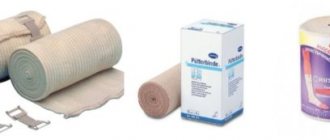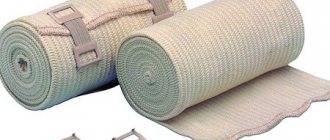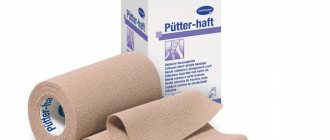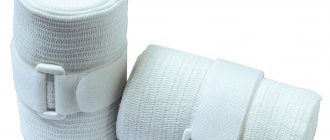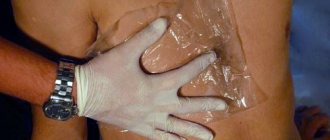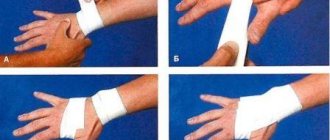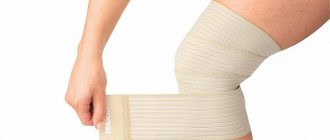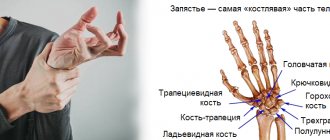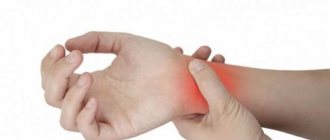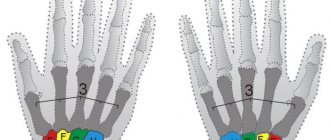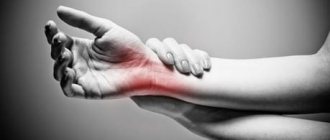If the wrist joint is damaged, it is very important to fix it in the correct position. Wrist pain can be caused by injury or chronic illness. When playing some sports, it is also recommended to use a bandage to prevent sprains and reduce stress on the joints. Applying an elastic bandage to the wrist is widely used, for example, in boxing, tennis, and gymnastics.
Wrist pain can also occur during professional activities. Most often, hairdressers, pianists, and people who work a lot at the computer are susceptible to it. Provoking factors may include diabetes and excess body weight.
An elastic bandage on the wrist is used to fix the joint in the correct position. Bandages vary in their degree of elongation, and the lower it is, the less pressure at the site of application. To securely fixate the injured limb, you need to use a bandage with a low degree of elasticity, and as a bandage for active sports, use a more elastic one.
What is it, benefits
Using an elastic bandage on the wrist can solve the following problems:
- fix movable joints, preventing sprains;
- distribute the load on muscles and ligaments;
- remove excess moisture from the body, which is especially important during active training.
It is recommended to fix the wrist joint with an elastic bandage in the following cases (if there is a corresponding doctor’s recommendation):
- arthritis, arthrosis, osteoarthritis;
- diseases associated with inflammation of muscles and tendons;
- paralysis;
- paresis;
- bone fractures;
- muscle strain in the wrist area.
Why bandage your hands?
Before you bandage your hands in boxing, you should understand why it is needed. Bandages reduce the risk of hand injury. They also increase the effectiveness of the exercises performed, which has a positive effect on the fighter’s training.
The main thing is to avoid common problems when winding:
- Folds. The resulting folds will not cause injury, but they will weaken the impact and may tear the skin.
- Squeezing. Leads to an outflow of blood, which reduces sensitivity or even hand tremors.
- Insufficient winding. This will lead to the bandage simply unwinding during training, which will require you to re-wind the bandage.
There are a lot of articles and literature on the Internet in which everything is beautifully described, but everything is checked and selected only from personal experience.
The need to limit the load on the wrist
Applying an elastic bandage to the wrist is performed for preventive and therapeutic purposes.
Prevention:
- preventing damage to muscles, tendons, joints;
- reducing the risk of inflammation and irreversible changes in bone and muscle tissue;
- reducing discomfort when performing monotonous, monotonous work.
When treating chronic or acute diseases, such as arthritis and arthrosis, applying an elastic bandage to the wrist allows you to:
- reduce the range of motion of the joint, which helps reduce swelling and pain;
- prevent the development of pathological processes;
- speed up the recovery of the injured limb.
In addition, the bandage has a massage effect on the tissue, which improves blood circulation in the damaged area and promotes a speedy recovery;
Part 4: Medical Care
- Make sure your wrist is not broken. A broken wrist or crack in the wrist bone requires immediate medical attention. You can tell that your wrist is broken by the following symptoms.
- Severe pain that gets worse when trying to grab or squeeze something.
- Swelling, immobility of the palm and fingers.
- Sensitivity, pain when putting pressure on the wrist.
- Dumbness in fingers and palm.
- Visible deformation, incorrect angle of the palm.
- Bleeding, rupture of the skin, protruding bone in an open fracture.
- Don't put off going to the hospital too long. Failure to visit a doctor promptly can significantly slow down the healing of your injury.
- Neglecting your wrist can cause difficulty regaining range of motion and the ability to hold objects firmly in the future.
- The doctor will take an X-ray of your wrist, which will show if there are any cracks or fractures.
- Monitor for symptoms of a scaphoid fracture. The scaphoid is a small boat-shaped bone located to the side of the main group of carpal bones. It is closest to the thumb. It is impossible to determine a fracture of this bone by external signs - it does not lead to external deformations or swelling. But there are a number of symptoms of a scaphoid fracture:
- High sensitivity, pain when touched.
- Weak grip.
- A few days after the fracture, the pain subsides, but soon returns in the form of a dull ache.
- Particularly severe pain occurs when pressure is placed on the tendons connecting the thumb to the palm.
- Contact your doctor if you notice these symptoms. Only a medical professional can confidently diagnose a scaphoid fracture.
- Do not waste time if the consequences of a fracture are severe. If your wrist is bleeding, very swollen or causing severe pain, then under no circumstances delay visiting a specialist.
- Other reasons to go to the doctor are pain when rotating the wrist joint, moving the palm or fingers.
- The same applies to muteness or complete immobility of the wrist, palm or fingers.
- If the injury appears to be minor and you decide to deal with it at home, then consult a doctor if the discomfort does not go away after several days of treatment or in case of complications.
How to apply
You can find out how to apply an elastic bandage to your wrist in each specific case by consulting with your doctor. Independent unskilled bandaging may not improve, but only worsen the situation and lead to more serious consequences. It is imperative to go to a medical facility if it is necessary to apply a bandage for medical reasons.
The general rules for applying an elastic bandage to the wrist are as follows:
- wrap the bandage around your wrist, starting from the inside;
- stretch the bandage diagonally across the outside of the palm, between the thumb and forefinger and back through the inside of the palm;
- wrap the bandage around the wrist and pull it in the opposite direction (along the inside of the palm, between the thumb and index finger) and through the outside of the palm back to the wrist;
- wrap your wrist and make several turns, partially overlapping the previous layer by at least half the width;
- secure the bandage.
It is also important to follow the following rules:
- the tension of the bandage should not be very strong, otherwise there is a high probability of disrupting blood flow in the affected area;
- The bandage should not be applied to swelling. To relieve swelling, you need to raise your hand up and hold it in this position;
- Bandage should be done from narrow to wide;
- There should be no folds or gathers, the bandage should not be twisted;
- Even tension should be maintained, otherwise the bandage will not hold well.
Types of bandages
Bandages have two indicators: length and elasticity.
The length of the bandages can be from 2.5 to 5 meters. This parameter depends on the physical characteristics of the person and the method of winding. The recommended length of bandages is 3 meters. This is important because a bandage that is not long enough will not be able to cover the entire hand and wrist, leaving the athlete unprotected from injury.
Elasticity, in turn, is also divided into two indicators: elastic or inelastic. The first ones adapt to the shape of the hand, and better fit the hand, becoming a “second skin”. But there is also a drawback to such bandages - if used incorrectly, the blood circulation process can be disrupted, which will negatively affect training.
Non-elastic bandages are safer in this regard. Made from cotton fabric, they cannot crush your hand. Such bandages are characterized by:
- When wrapping, the boxer immediately feels how hard he squeezed his hand.
- Fabric made of cotton and paper perfectly absorbs moisture, preventing damage to the gloves inside.
- Over time, the cotton material will stretch and begin to perfectly follow the curve of the brushes, fitting it completely.
Basic dressing methods
There are many ways to apply an elastic bandage to the wrist. They vary depending on the problems that need to be solved;
- to bandage the wrists when doing boxing and weightlifting, a bandage with a length of at least 4.5 m is required. In this case, applying an elastic bandage to the wrist begins with a loop on the thumb, gradually covering the entire palm with the bandage, and the bandage is passed between all fingers;
- for cuts, the method of bandaging the palm from the wrist to the knuckles is used;
- for bruises, ruptures and sprains, an elastic bandage on the wrist covers the area from the elbow to the area below the knuckles.
The HARTMANN catalog contains a wide range of elastic compression bandages Idealast and Lastodur. Products are available in different lengths, widths and degrees of stretch. Self-fixing bandages are securely held without additional fastening. The high cotton content guarantees a comfortable feeling. Microdot impregnation with hypoallergenic glue allows the product to be used by people prone to allergies. The bandages can be washed at temperatures up to +60 ℃, which is very important both when using them as a sports bandage and for medicinal purposes.
To buy a bandage or other Paul Hartmann products, place an order on our online store website. Qualified managers will help you navigate the catalog and choose a product that meets your needs. You can ask all your questions to the online assistant.
IMPORTANT: both prevention and treatment can only be prescribed to you by a doctor! Before purchasing bandages, be sure to consult a doctor.
Part 2: Caring for an Injured Wrist
- Treat your injury at home. Minor wrist injuries, such as muscle and ligament sprains, can be treated at home without visiting a doctor.
- Excessive use can strain the muscles or tendons that attach the muscles to the bones.
- Ligaments connect human bones into a single mechanism and can also stretch or tear under load.
- The symptoms of muscle and ligament sprains are similar. In the damaged area, pain, swelling, and decreased mobility of the injured joint or muscle occur.
- Bruises and crunching when injured are frequent companions to sprains. And when muscles are stretched, cramps often occur.
- Treat the wrist using the R- I- C- E technique.
RICE means Rest (from the English Rest), Ice (from the English Ice), Bandaging (from the English Compression, in this context we are talking about bandaging), Hold higher (from the English Elevation)
- Both muscle strains and sprains should be cooled and bandaged regularly. At the same time, try to use your healthy hand in everyday activities, keeping the injured wrist at rest.
- Don't overload your wrist. Try to keep it at rest for several days after the injury, this will significantly speed up the healing process. Rest is the most important element in caring for an injured wrist.
- Rest involves complete release of the wrist from any activity. If possible, do not use your injured arm at all during the day.
- Do not lift heavy objects or twist or bend your injured wrist. In severe cases, you should also stop holding a pen or computer mouse in your affected hand.
- To properly secure your wrist, you can purchase a special bracelet. This is especially recommended for tendon injuries. The brace supports the wrist, preventing complications from existing injuries.
- Cool your wrist. When a cold compress is applied, the low temperature is quickly transmitted to the deep tissues.
- The cold will reduce blood flow to the damaged area, which will relieve swelling and inflammation.
- If you don't have a compress on hand, you can apply a bag of frozen vegetables or almost anything you find in your freezer to your wrist. Wrap your ice in a towel: do not apply cold objects directly to the skin.
- Keep the ice on for no more than 20 minutes, then let your wrist warm at room temperature for an hour and a half. In the first 72 hours after injury, repeat the procedure as often as possible, at least two to three times a day.
- Wrap your wrist with bandages. You need to bandage your wrist to prevent swelling. It also provides wrist support and prevents unwanted and painful hand movements.
- When wrapping your hand in elastic bandages, start bandaging from the palm and then move to the wrist. Continue wrapping up to your elbow. Maximum fixation is achieved with complete bandaging from the knuckles to the elbow.
- You should start with the palm of your hand to avoid swelling in the damaged area, located closer to the heart.
- Each subsequent turn of the bandage should cover at least half the width of the previous turn.
- Make sure the bandages are not too tight. They should not interfere with blood circulation.
- Remove bandages regularly to cool the injured area.
- Don't go to bed with your hand bandaged. In some cases, your healthcare provider may recommend special techniques to support your wrist while you sleep. Consult your doctor for detailed instructions.
- Keep your wrist elevated. This will help relieve pain, swelling and bruising.
- Keep your wrist above the level of your heart when applying cold compresses, before applying bandages, and while resting.
- Continue applying bandages 72 hours after the injury. Full healing may take four to six weeks. Remember to apply bandages during this time to avoid worsening the injury.
- Develop wrist mobility. As you heal, gradually begin using your injured arm in daily activities.
- A slight discomfort when moving the joint and performing rehabilitation exercises is acceptable.
- If necessary, resort to pain relievers such as aspirin or ibuprofen.
- Avoid any activity that causes severe pain. If everyday movements or exercises are unpleasant for you, then give your wrist some more time to recover.
- Each person's body is individual. But with proper care, wrist injuries heal on average in 4-6 weeks.
COACH ADVICE
When performing health-improving exercises, be guided by the following rules: do not overestimate your physical capabilities, do not strive for maximum range of motion, do everything without tension. Never force the load, but increase it gradually, day by day, as your physical fitness improves. Especially if you are taking up physical exercise for the first time or have had a long break from exercise. Women who want to lose weight faster usually do weight training. If you feel pain in your joints during and after exercise, you need to pay more attention to warming up, reduce the weight of the weights and apply fixing elastic bandages to the areas of the knee and elbow joints, wrists, and ankles. This will not only relieve pain, but will also make you feel much more confident.
HEALTH AND JOY OF MOVEMENT
What could be more important than feeling good? Physical vigor, energy, and an optimistic attitude are the key to our success in business, career advancement, and simply a feeling of joy from every new day.
Spending the whole day in the office or busy at home, on vacation we strive to change our surroundings, move around, run, play sports, and work in the garden.
However, unusual movement activity almost always carries a risk of injury. An awkward turn of the foot leads to rupture of the ligaments, a sharp jerk leads to a dislocation of the joint. But now first aid has been provided, the stress is over. How to quickly return to normal life, relieve pain and swelling? TONUS ELAST advises: always have an effective, inexpensive and effective product on hand - elastic medical bandages.
DOCTOR'S ADVICE
Along with the treatment that the doctor will prescribe for you, the body must receive a sufficient amount of substances that help strengthen blood vessels and prevent the formation of blood clots.
For diseased veins, it is necessary to follow a diet with a minimum of salt and spices, eat food rich in vitamins and fiber, and drink freshly squeezed juices. Try to avoid anything fatty, overcooked, or smoked.
Avoid products with a large number of synthetic additives, as well as those made from refined white flour and polished rice.
Pay attention to two vitamins that are especially important for you: P (rutin) and R (thiamine hydrochloride).
Monitor your total caloric intake and try not to gain excess weight.
The effect of bandaging is obvious - the diameter of the veins decreases, swelling subsides, pain in the leg and a feeling of heaviness disappear. Compression not only promotes the healing of trophic ulcers, but is also an effective prevention: the pressure of the bandage in combination with movement increases the speed of blood flow by approximately two times, reviving metabolic processes. Bandaging is useful for any form of venous insufficiency.
Results of using the orthosis
PROP The Prometer unloads and also secures the joint in a certain position and, with the help of an orthosis, reduces pain. The injured area remains stationary; compression and warming effects lead to increased blood circulation and lymphatic flow.
In cases of displacement, the fixator is used in complex therapy and is able to eliminate the resulting deformation. The effectiveness of the fixator depends on the correctness of its choice, which should be carried out together with the doctor after diagnosis and examination of the victim. It is the doctor who regulates the level of fixation of the orthosis and the period of its wearing.
Return to list
Indications and contraindications for the treatment method
If you have mild lymphedema (stage 0 or 1), you can only use compression garments. For stage 2 and 3 lymphedema, it is recommended to first develop a treatment program called total decongestant therapy to reduce swelling. Undergo bandage treatment and then use compression stockings. Banding is contraindicated if:
- The patient has stage 0 and stage 1 lymphedema: it requires other forms of compression.
- The area to be bandaged is infected.
- There is an open wound.
- The patient has severe arterial obstruction.
Graduated compression should not be used in the presence of the following pathologies:
- Arterial Pathology: Compression of small arteries will further reduce blood flow, create pain and reduce blood supply.
- Diabetes with neuropathy.
- Wet dermatosis (reddened skin, abrasive surface, secretion of serous fluid).
- Skin ulcer (not caused by venous insufficiency).
- Eczema.
- Arterial circulation disorders.
- Painful Raynaud's pathology with damage to the arterial wall.
Congestive heart failure or the presence of blood clots are conditions where you need to discuss special precautions regarding ligation (or any other form of compression) with your doctor.
DOCTOR'S ADVICE
At the first signs of varicose veins, begin to act immediately:
- avoid excessive physical activity, do not lift weights;
- do not stand motionless for a long time; - lose excess weight; - wear low-heeled shoes (no higher than 4 cm);
- take the stairs more often;
- avoid overheating: long sunbathing or hot baths;
- do a contrast shower for your feet;
- while resting, place your legs on a raised platform so that your feet are 15 cm above the level of your heart;
— vigorous walking (but not running), swimming, cycling are good.
Vein disease affects women twice as often because their veins are naturally thinner and their connective tissues are weaker. An additional provoking factor may be pregnancy.
PREGNANCY AND VARICOSE
A pregnant woman is at significantly greater risk of developing varicose veins. The reason is hormonal changes in the body and increased body weight, which puts additional stress on the veins.
What can be done for veins during pregnancy? Even if none of the family members have venous diseases, do not forget to do gymnastics to train the veins and breathing exercises for better blood supply. And the use of elastic bandages will help relieve swelling of the legs.
Rehabilitation period
The recovery period depends on the degree of damage to internal tissues, the physiological characteristics of the body, as well as compliance with bed rest and doctor’s recommendations.
Minor bruises do not require rehabilitation and go away on their own in a few days.
After receiving more serious injuries, the patient will need a long time to restore full functionality of the leg. In especially severe cases, the patient is bedridden, and during the period of rest the muscles atrophy and require special development.
To speed up the recovery process, you will need the help of a qualified specialist who will assess the condition of the muscles, joints and ligaments, after which he will prepare a set of exercise therapy , massage and physiotherapeutic procedures, including UHF and electrophoresis.
Photo 2. Massage helps improve blood circulation and accelerate injury healing. : Flickr (Adnilza Oliveira).
Compression therapy with elastic bandages
Compression therapy is the use of a variety of elastic and non-elastic bandages, compression products, and hardware that create pressure on the surface of the human body, spreading to deeper organs and tissues, which leads to the development of a therapeutic and/or preventive effect.
Today, compression therapy is the main method of treating any venous diseases, regardless of the cause of their development and the stage of the process, which has proven high efficiency (level of evidence A and B) and has virtually no contraindications or side effects. Compression therapy eliminates symptoms such as swelling, pain and heaviness in the legs, cramps, promotes regression of trophic disorders, and also allows for the prevention of thrombosis of superficial and deep veins, progression and relapse of the disease after surgical treatment.
The therapeutic and preventive effect of compression products is realized through four main mechanisms:
- Compression of the intermuscular venous plexuses and perforating veins leads to a significant decrease in pathological venous capacity (hypervolemia) of the lower extremities, thereby increasing the efficiency of the muscular-venous pump
- Reducing the diameter of the vein leads to improved functioning of the relatively incompetent valve apparatus and an increase in the speed of venous blood flow, which reduces blood viscosity and reduces the risk of thrombosis.
- An increase in tissue pressure (including pressure in the area of edema) leads to an increase in the return of extracellular fluid into the capillary bed and a decrease in its exit from the capillaries, which reduces the phenomenon of edema. This mechanism is realized when compression exceeds 30 mmHg. Art.
- Increased fibrinolytic activity of the blood due to more intense production of tissue plasminogen activator, which reduces the risk of thrombosis against the background of altered blood flow. This is due to muscle contraction to a limited extent
Contraindications to the use of compression therapy:
- chronic obliterating diseases of the arteries of the lower extremities, when regional systolic pressure on the posterior tibial artery is below 70 mm Hg. st and ankle-brachial index less than 0.8
- severe forms of diabetic polyneuropathy and angiopathy
- acute phlebothrombosis with pronounced disturbances in blood outflow due to insufficiency of collaterals (blue phlegmasia), up to the restoration of sufficient throughput of the venous bed
- decompensated cardiopulmonary failure
- trophic ulcers of non-venous etiology
- acute soft tissue infection
- septic phlebitis
Compression bandage using elastic bandages
The most common method of compression therapy is the formation of compression bandages. This is due to their high efficiency at relatively low costs. To create bandages, bandages of varying degrees of extensibility are used. The degree of compression when using a bandage is directly proportional to the extensibility of the material and inversely proportional to the diameter of the limb. Given the complex and individual anatomical configuration of the lower extremities, adequate application of the bandage is a difficult task not only for the patient, but also for medical personnel. As practice shows, no more than 5% of patients master the skills of properly bandaging a limb. Others apply a bandage with such errors that can only lead to a worsening of symptoms.
Long stretch bandages
provide the highest possible degree of compression at rest (the pressure level with an incorrectly applied bandage can exceed 100 mm Hg!). The main indications for their use are the first day after phlebectomy to prevent deep vein thrombosis and intradermal hemorrhage, as well as acute deep vein thrombosis and varicothrombophlebitis.
Medium stretch bandages
provide a moderate degree of compression at rest and its increase with contraction of the lower leg muscles. They are used for all stages of chronic venous insufficiency (1-6 according to CEAP), for the prevention of venous thromboembolic complications, after phlebosclerosing treatment, for the treatment of deep vein thrombosis and thrombophlebitis in the subacute stage.
Short stretch bandages
provide a low and well-tolerated level of compression at rest and its significant increase with contraction of the lower leg muscles. They have high rigidity, which allows them to compensate for the increased pressure in the superficial veins in patients with severe forms of venous insufficiency. They are used for CVI in the stage of trophic disorders (stages 4-6 according to CEAP), as well as after sclerotherapy of large veins and for the treatment of lymphedema.
Non-stretchable bandages
do not create resting pressure, but have maximum rigidity, creating an external frame that prevents an increase in pressure in the veins in patients with severe forms of venous insufficiency. In this case, there is a maximum increase in pressure when walking compared to other bandages. They are used for the treatment of severe trophic disorders (CVI stages 4-6 according to CEAP).
The effectiveness of treatment of trophic disorders can be increased by impregnating the bandage with an active component, for example, zinc oxide, which has a positive effect on the condition of the skin, stimulates reparative processes, and accelerates the healing of trophic ulcers. An example is the non-stretchable bandage with zinc impregnation Varolast, which is widely used for the treatment of trophic ulcers of venous etiology.
There are also bandages
adhesive
(self-adhesive to the surface of the skin due to impregnation with zinc oxide or other adhesive substance - Varolast) and bandages
cohesive
(the tours of which reliably “stick” to each other due to fine-point inclusions of latex on the surface of the bandage, ensuring long-term and reliable fixation of the entire bandage on the limb and increasing its rigidity - Idealhaft, Idealast-haft, Idealast color cohesiv).
Indications for the use of this or that type of bandage
| Type of bandages | Length increase | Indications |
| Inelastic | 0 |
|
| Short stretch | Less than 70% |
|
| Medium stretch | 70–140% |
|
| Long tensile | More than 140% |
|
It should be especially noted that highly extensible bandages (and these are, in particular, the very popular “Laume” products in our country) are not applicable for the treatment of patients with CVI
The main indications for using a compression bandage today are:
- pronounced and/or acute edema in case of CVI and venous thrombosis (due to the possibility of a rapid change in the volume of the limb during treatment)
- trophic ulcers with massive exudation, which requires frequent changes of bandage and care of the wound surface
- trophic disorders such as indurative dermatitis, cellulite, eczema, when disturbances in the water-temperature balance and air exchange of the skin when using compression knitwear are undesirable
- the first 1-3 days after phlebectomy to create adequate pressure, including on the thigh, in order to prevent and reduce the severity of postoperative hemorrhages
- after sclerotherapy of subcutaneous lines, large tributaries on the thigh, veins in the area of trophic disorders
- for the purpose of preventing venous thromboembolic complications after emergency surgical interventions, when the selection of knitwear is very difficult
- in patients with diseases of the musculoskeletal system who experience difficulties in using compression stockings
- with individual characteristics of the limb and the impossibility of selecting adequate knitwear
In these situations, frequent, sometimes up to several times a day, bandage changes are required, so elastic bandages are the means of choice. In other cases, preference should be given to medical compression hosiery, which does not have all the disadvantages of a compression bandage (see below).
Rules for forming a compression bandage from bandages:
- the bandage is applied when the foot is dorsiflexed, which prevents the formation of folds in the ankle area, since folds can damage the skin during movement
- the bandage should reach the joints of the toes and grip the heel
- the pressure of the bandage should gradually weaken from the ankle towards the thigh
- when applying a bandage, the roll of bandage is untwisted outward, while it is in close proximity to the skin
- it is necessary to model the cylindrical profile of the limb by placing foam rubber or latex pads on its flat parts (dorsum of the foot, ankle fossa). To prevent pressure sores of the skin in areas of the leg with a small radius (ankle, tibia), foam rubber or latex pads (Rolta soft) are applied.
- the application of a compression bandage must correspond to the shape of the leg, i.e., with a conical shape, the bandage rounds should go in the ascending and descending directions
When a compression bandage is applied correctly, the fingertips turn slightly blue at rest, but at the beginning of walking they return to their normal color. Compression bandages are changed daily or applied for a long period (up to 2 months). The bandage should be applied in the morning in bed before getting up, and removed in the evening before going to bed.
One of the simplest, from a technical point of view, and at the same time reliable and effective methods of applying a compression bandage according to Fisher-Schneider. For a compression bandage, use 2 bandages with a width of 8 and 10 cm. Bandaging begins with an 8-centimeter bandage. The first round begins directly at the base of the toes with its dorsiflexion at 90°. The bandage covers the heel and lower third of the leg until the Achilles tendon passes into the muscle. The second bandage (10 cm) is applied following the configuration of the leg, up to the head of the fibula. In this case, it is necessary to cover the heel in the form of a “hammock”. When using the Fisher-Schneider double-layer dressing technique, two 10-centimeter bandages are applied sequentially - the first from the base of the toes to the popliteal fossa, the second on top of the first in the opposite direction.
Types of hand orthoses
All orthoses are classified by area of use and form 3 groups:
- The first category consists of orthoses designed for the spine. It includes: corsets, splint collars, reclinators and bandages.
- The second group consists of orthoses used for injuries to the joints of the upper limbs, such as elbow pads, shoulder braces, and wrist orthoses.
- The third category includes leg orthoses with the function of fixing the joints of the lower extremity belt: knee pads, ankle pads, orthoses for the pelvic area, orthopedic insoles, shoes.
According to production options, orthoses are divided into:
- Finished - products produced in a factory. The specific type of such prosthesis is prescribed to the patient by the doctor.
- Individual. Such an orthosis is created for each patient. The anatomical features of the structure of the damaged organ and the type of pathology are taken into account.
The human wrist is often injured because it is the most mobile area of the hand. Common wrist injuries include sprains and sprains. The doctor determines an orthosis for the wrist joint in order to ensure that the joint is secured in a semi-rigid or light form. Visually, such a retainer is similar to a glove, which firmly secures the wrist in a certain position and prevents it from moving.
Such an orthopedic device restrains movement and, in case of urgent need, completely immobilizes it, which reduces the sensations of pain and discomfort and facilitates the rapid recovery of the damaged joint after serious damage.
Orthoses can also be divided according to their level of rigidity:
- Rigid wrist joint orthoses are used during rehabilitation after fractures. Rigid clamps completely secure the wrist.
- Semi-rigid orthoses are used during rehabilitation after minor injuries.
- Soft ones are used as preventive measures against the occurrence of possible wrist injuries.
